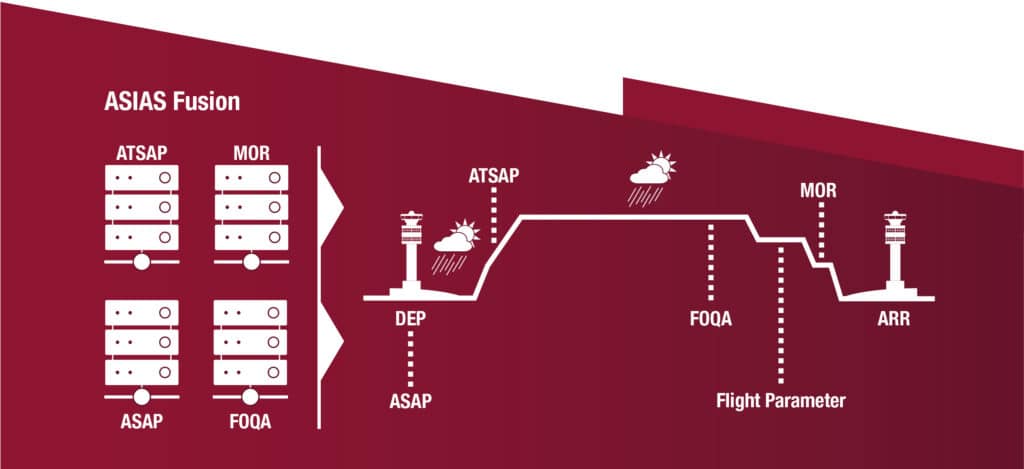Several factors play a critical role in aviation’s goal of continuous safety improvement. One of the most important is the sharing of incident data. This practice, which originated in simple observations shared informally within flight departments, has been enhanced by technology and the efforts of many industry experts advocating for its increased adoption.

Today, data recorded and categorized following a set of standards and made widely available is helping aviation organizations learn from the experiences of others and avoid costly property damage, serious injuries and even fatalities. The information gained on problems encountered and solutions identified has enormous value in enabling organizations to predict accidents and implement mitigations to help prevent them. Aviation businesses of all types and sizes, and all functional areas within them, are benefiting from implementing data sharing practices.
De-Identified Information as the Cornerstone of Data Sharing
Despite the clear and significant benefits of data sharing, aviation professionals are often conflicted about documenting incident information and making it available to others. Pilots, operations managers and others, who are collaborative by nature, want to contribute to the body of knowledge that is powering aviation safety improvement. However, they are concerned about the repercussions if reports expose errors on their part or that of their peers.
What may not be as widely known as it should be is that today’s data-sharing systems completely de-identify information at many levels before making it available. No one involved in developing, managing or promoting these systems wants to create problems related to confidentiality for those prepared to share information. Their singular focus is disseminating vital information that can prevent property damage and injuries.
The Many Forms of and Forums for Data Sharing
Pilots, flight crews, ground crews and other stakeholders can share their operational challenges and strategies for success in several ways. This includes through the FAA’s Aviation Safety Information Analysis and Sharing (ASIAS) program and hundreds of data and information sources across government and industry that feed into its data repository.
“Scheduled air carriers have been sharing safety data for decades, resulting in an incredibly low accident rate. Bottom line: Sharing data works to reduce accidents and risks,” says Baldwin Safety and Compliance President Don Baldwin. “The business aviation community is just getting started in data sharing through ASIAS and regional safety sharing programs. These low-cost tools are effective and readily available today for all operators, large and small. I can’t emphasize enough how important data sharing is for reducing accidents and risks to the low levels achieved by commercial air carriers.”
But these systems are not the only avenues for gathering and disseminating incident details and solutions. Internal hazard reporting databases, automated flight operations quality assurance (FOQA) technology and even internal mentorship programs are effective ways to share data. They can help everyone “learn from the mistakes of others”—which is a safe and highly effective form of aviation education.
Data Vetting and Decision Autonomy
Individuals and organizations that participate in data-sharing programs surely do so in good faith and with the belief that their information will promote the common good in aviation. That being said, entities that collect data typically vet it to a degree, which is helpful, particularly for smaller aviation organizations that may have no prior experience with a particular scenario and no framework for assessing the effectiveness of a solution.
Of course, the value of aggregate data to a particular organization is further enhanced by its team members balancing it with their own experiences and knowledge of their risk environment. Data analyzed and acted on in this way has the greatest potential for improving operations and enhancing safety.
Hurdles to Information Dissemination
It is important to recognize that many factors can contribute to aviation organizations not actively participating in data sharing. One is the belief that uncovering ongoing issues will force the business to incur costs related to changing processes or providing specialized training.
Another factor is that some stakeholders simply have not been exposed to data sharing and consequently do not fully understand its benefits. And even when they have learned about its advantages and are ready to move forward, initiatives often stall when decision-makers realize they do not know how to get started in data sharing.
Fortunately, there are ways to overcome objections to data sharing. For instance, it can be beneficial to explain to stakeholders that transparency about incidents and a commitment to viewing mistakes as learning opportunities can decrease employee turnover, which can be significant and costly for
these organizations.
Promoting a continuous-improvement culture can also catch the eye of potential clients, resulting in increased business opportunities. In addition, aviation businesses reluctant to report incidents can be shown how their industry peers have benefited from data sharing and how their organization could leverage the practice.
Steps To Expanded Data Sharing
Organizations should understand that data sharing does not have to be an “all-in” proposition. Aviation businesses can and do provide varying amounts of information to various data management systems. Often, submitting certain types and limited quantities of incident reports helps build trust in the collection and analysis process. Then, as the organization’s confidence grows, it increases the depth and breadth of its reporting.
Many organizations start with actions as simple as encouraging line personnel to have conversations with flight crews when an incident occurs. Open and honest discussions focused on identifying causes and brainstorming solutions can set the stage for sharing details about incidents more broadly. Were there visual distractions (an awareness issue)? Did they push the wing into the fence because they didn’t know that the wing grows when the aircraft turns (a training issue)? Was an action completed hastily by an overworked team member (a staffing issue)?
The key is for an aviation entity to get started in data sharing in the ways and to the degrees that align with its comfort level as a foundation for greater involvement. Some organizations begin with internal sharing, progress to NDA-governed local roundtable discussions, move on to using local or regional systems and finally begin providing information to national databases.
As for leveraging collected data, there are essential elements for maximizing its value. First, aviation organizations must learn about where they can obtain data. Like reporting options, data sources may be local, regional or national. Next, entities should consider how they can use the information. And finally, they must evaluate the reports and implement the appropriate mitigations for their operations.
The Future of Aviation Data Sharing
The outlook on the collection, categorization and dissemination of “clean,” de-identified aviation incident data is bright. Stakeholders are increasingly confident in the process, aware of the benefits and eager to capitalize on collective insights to improve their operations.
Much work remains for everyone in aviation to increase awareness of the importance of data sharing and encourage participation in programs at all levels. But the progress to date and steadily growing body of knowledge are already positively impacting aviation safety.
One can envision and hope for a future in our increasingly connected world, where the vast majority of aviation incidents are reported in near-real-time fashion, providing immeasurable benefits to our industry and everyone who participates in or relies on it.

